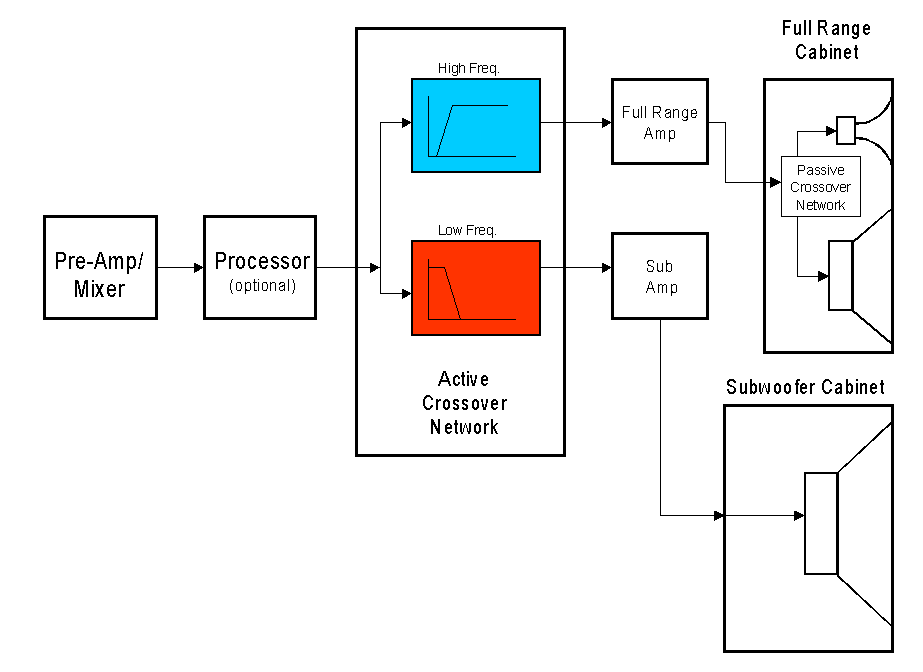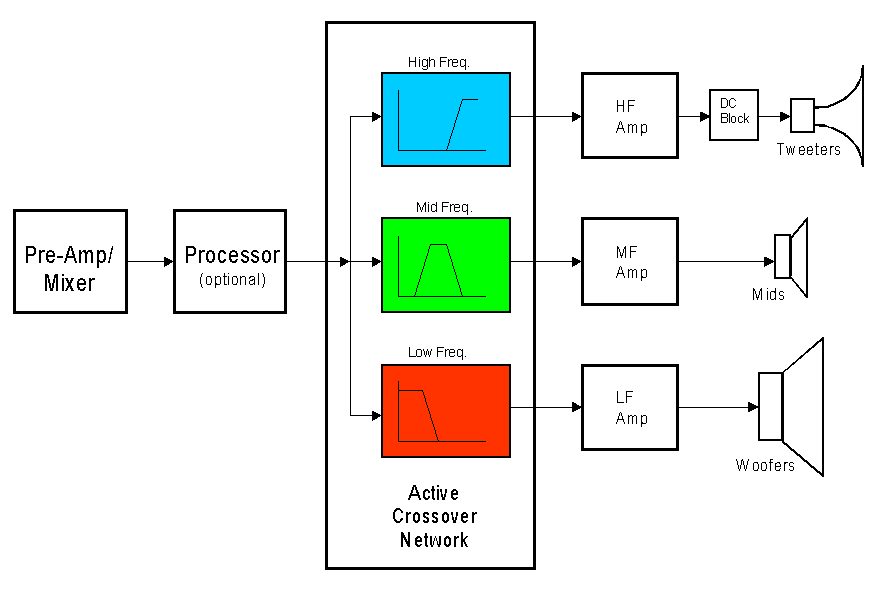
Updated 26 Dec 2005

Rev - 26 Dec 2005
What exactly does the term "bi-amplification" and "tri-amplification" mean? It means that there are separate amplifiers to drive individual woofers, tweeters, and in the case of tri-amplification, midrange speakers. Why would anyone want to do this? There are lots of attractive advantages:
However, nothing is free, and of course there are some non-trivial disadvantages associated with multi amp systems:
Today, most of the high power audio systems in automobiles are bi-amped (and some are tri-amped). In most such car systems, there is separate amp for the subwoofers and another amp for the full range drivers. In home theater systems, the situation is similar. Some DJs (with larger systems) and nearly all large audio touring outfits use bi and tri amplification for their sound systems. Some outfits use 4 and 5 way systems, but these are limited to the most powerful of audio systems.
For the latest trend in Home theater speaker systems join the Home theater forum and learn from reviews, deals and more!
The figure below a typical bi-amplified sound system:

Let's take a look at this system. At the left is a pre-amp (or mixer), this is required for any audio system. Next is a processor... this is an optional device. It could be an equalizer, a compressor, noise gate, or any other device that the system designer deems necessary. From here the audio signal feeds into the Active Crossover Network. In this case, we show a dedicated (separate) unit (in some cases power amplifiers have crossovers built into them, but normally in such cases they are not as versatile as a separate dedicated crossover unit). The purpose of the active crossover network is to break the audio signal into separate frequency bands (in the case of bi-amplification, two frequency bands, high and low). Note that most dedicated active crossover networks allow the use to set the frequency as desired, often from as low as 40 Hz to as high as 12,000 Hz. For most bi-amp systems, the crossover frequency would likely be somewhere around 100 Hz to 200 Hz. In Figure 1 we show a system that uses a full range speaker system (for example a system with a 12" woofer and a horn tweeter) and also a separate subwoofer cabinet (with an 18" woofer). The full range system by itself produces some decent sound, but the low end bass is not real strong. This is why we want to add the 18" sub (such a speaker is much better at high output low end reproduction as compared to the full range speaker). In order to get the maximum fidelity out of these speakers, the crossover separates the very low notes and the remainder of the audio signal (consisting of mid bass/mids/highs in this example) into two paths. The crossover itself is a low level signal device (it is not designed to drive speakers), rather its output is then fed to individual power amplifiers. Another nice feature of most electronic crossover networks: they often have steep slope filters (such as 4rth order Linkwitz-Riley filters) and they almost individual output level controls for each band. The steep slope filters are very good at keeping low frequencies out of the high band (and vice versa), and the level controls are great for adjusting the sound level that is output to each amp (most power amps have input level controls also, but in case they did not the crossover allows for the adjustment).
Now that the crossover has broken the audio signal into two bands, these two signals are then sent to two power amplifiers. One amplifier covers the very low notes (for the sub) and the other amp handles the mid bass/mids/highs to the full range speaker. Note that the full range speaker (in this example) has its own internal passive crossover network; this is still required!
In this example, we are "reliving" the full range cabinet from having to deal with the reproduction of the very low notes. In doing so, we have also reduced the distortion of the full range speaker (most full range speakers have fairly high distortion when trying to reproduce loud, low frequency notes while also simultaneously trying to play all the other music). By letting the sub concentrate on what it is best at, the full range cabinet (and the entire system) will sound a lot better than just the full range alone!
Figure 2 below shows a tri-amplified sound system:

The overall operation of this tri-amplified system is much the same as the bi-amplified system, however the active crossover network for this case is a 3-way unit. The sound system shown in this diagram is typical of what may be found in a large professional touring sound company. In such systems, there are often separate dedicated speaker cabinets: subwoofer cabinets, midrange cabinets and arrays of tweeters. There is one area where one needs to be careful when using dedicated tweeter amplifiers. Note that in a tri-amplified system (like that shown above), if the HF amplifier is direct connected to the tweeter, it leaves the tweeter open to damage should any high amplitude low frequency sounds end up being output to the tweeters. How can this happen? Isn't the crossover supposed to knock out all the low frequency sound? Yes... however, when some amplifiers (or other units in the audio system) are powered up or down, large amplitude low frequency "thumps" can propagate through the system and these can easily destroy tweeter drivers! This can happen even with a highly experienced and qualified sound system operator (for example an unexpected AC power glitch could cause this). So, it is high recommended to have some kind of a safeguard in place for the tweeters. This is not hard to do and most often all that is needed is a capacitor (of appropriate type, rating and value). If the midrange drivers are of the horn type, it is also suggested that they too have some type of similar protection (professional cone midrange drivers are usually very rugged and not easily damaged in this manner).
When using a bi or tri-amplified system, how does one know what power ratings to select for the system? This depends on several factors:
Normally, tri-amplified systems are used for larger venues because it is not ideal (or often not practical) to use full range speakers driven by one gigantic amp. However, one can use a tri-amplified system in a small venue to gain the benefits outlined above (better overall sound as compared to a similarly powered full range system). The next question to be answered is "what are the ratings of the speakers being used?" Finally, and one of the most important factors is the choice of crossover frequencies. For normal music, the majority of the power (60-70%) ends up in the woofer band, maybe 25-30% ends up in the midrange band, and around 10-15% in the tweeter band. The actual numbers may vary depending on the type of music being played. Another thing to remember: in general, midrange and tweeter drivers are considerably more efficient than woofers. For example, an 18" woofer may have a sensitivity of 98 dB/W/M, a midrange driver might have a sensitivity rating of around 101 dB/W/M and a horn tweeter might have a rating of something like 105 dB/W/M. Remember, a speaker with a sensitivity rating 3dB higher than another requires only ONE HALF the power to get the SAME loudness out! Another thing to remember: midranges and tweeters cannot handle as much power as a similarly matched woofer. So, when choosing amplifiers for the various bands, we not only have to account for the fact that the amps for the higher bands won't get as much signal, they are also driving speakers that generally put out a lot more sound per watt! So, you may not need as powerful an amp for the mid and high bands as you might first expect! Here's a real world example: when I ran my pro-system (bi-amped) I had the crossover at around 300 Hz (from 18" subs to a 10" woofer/horn tweeter cabinet with a passive network between the 10" and the horn). I used a 900W amp for the bass and a 350W amp for the mid-high band and found that this was an excellent balance for the system I was using). For true 3-way systems (with tweeter crossover frequency at around 5000 Hz), a 50 watt amp may be all that is needed (50 watts per tweeter). Due to the vast range of possible systems, we can only cover rough numbers in this article. The exact amplifiers and crossover frequencies are needed for a particular system depend on too many factors to allow any simple formula to be used.
When using a multi-amp system (especially those with dedicated crossover units), the overall system wiring gets a lot more complicated as compared to a single amp system. In most pro systems, balanced audio cables are used (either TRS 1/4" connectors or XLR connectors). With so many components in the system, it is easy to end up with ground loops that result in hum or other undesirable problems. I have never seen a system where such problems could not be corrected (the majority of the time such problems are due to improper wiring of the system). Wiring of such systems does require a detailed knowledge of proper system wiring techniques (more than I can cover in this article at this time). However, there is one thing I can say clearly: eliminating system noise and hum by cutting off the "third prong" of an audio component is NOT the proper way to cure these kinds of problems. While this may work in some cases, the problem almost certainly originates in incorrect wiring in the audio cables, it is NOT caused by the ground prong being present. Cutting off the ground prong (or "lifting" it using a 3 to 2 wire adapter) should be avoided (this will violate code in most places). It can leave the system in a potentially unsafe (shock hazard) situation. If you have a system with noise problems and are unable to locate the source of the problem, call in an audio professional to assist.